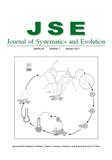Yin-Zheng WANG, Ru-Bing MAO, Yan LIU, Jia-Mei LI, Yang DONG, Zhen-Yu LI, James F. SMITH
Chirita D. Don, a large genus in the subfamily Cyrtandroideae of Gesneriaceae, has been the subject of much debate whether it is a natural group or not. In addition, the highly heterogeneous Chirita has also been very problematic with regard to delimitation and subdivision. Here we used the nrDNA internal transcribed spacer and cpDNA trnL-F for molecular phylogenetic analaysis, combined with morphological data. Our results suggest that Chirita is an artificial, polyphyletic genus. The most important character that defines Chirita, the dorso-ventrally oblique and bilamellar stigma, has evolved convergently in different clades of diandrous Cyrtandroideae. Chirita sensu stricto only includes the species of Chirita sect. Chirita, whereas Chirita sect. Microchirita is an independent clade located at the basal node of the phylogenetic tree. Chirita sect. Liebigia is closely related to Didymocarpus with an entire stigma unlike other species of Chirita. The species of Chirita sect. Gibbosaccus, Chiritopsis, Primulina, and Wentsaiboea form a monophyletic group that is sister to a strongly supported clade comprising four monotypic genera Paralagarosolen, Calcareoboea, Petrocodon, and Tengia. We further analyzed the morphological evolution of Chirita and identified a series of morphological synapomorphies for the monophyletic groups revealed herein, and thereby provide a taxonomic treatment in this study.

